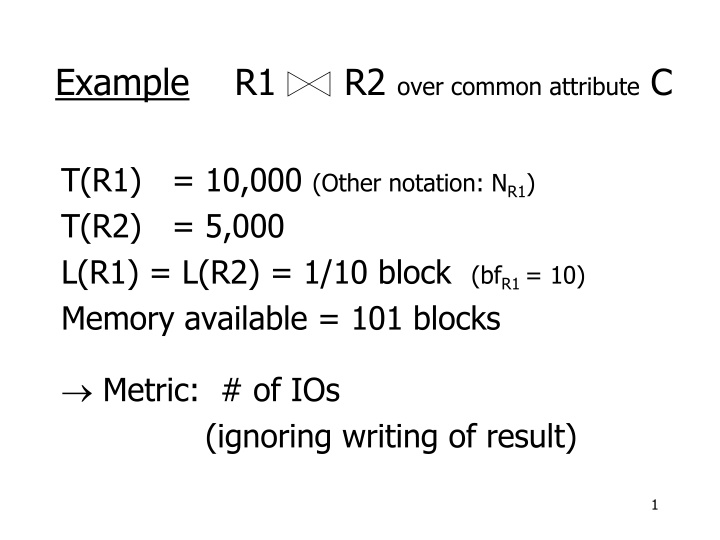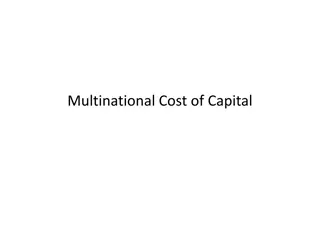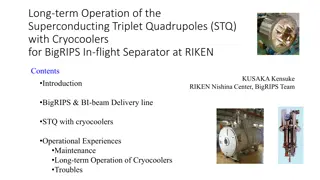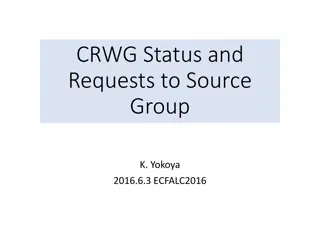
Memory Management Strategies for Join Operations in Databases
Explore various memory management strategies for optimizing join operations in databases, such as iteration join, reverse join order, merge join, and considerations for contiguous relations. Understand the costs and IOs involved to improve performance and efficiency.
Download Presentation

Please find below an Image/Link to download the presentation.
The content on the website is provided AS IS for your information and personal use only. It may not be sold, licensed, or shared on other websites without obtaining consent from the author. If you encounter any issues during the download, it is possible that the publisher has removed the file from their server.
You are allowed to download the files provided on this website for personal or commercial use, subject to the condition that they are used lawfully. All files are the property of their respective owners.
The content on the website is provided AS IS for your information and personal use only. It may not be sold, licensed, or shared on other websites without obtaining consent from the author.
E N D
Presentation Transcript
Example R1 R2 over common attribute C T(R1) = 10,000 (Other notation: NR1) T(R2) = 5,000 L(R1) = L(R2) = 1/10 block (bfR1 = 10) Memory available = 101 blocks Metric: # of IOs (ignoring writing of result) 1
Options Transformations: R1 R2, R2 R1 Join algorithms: Iteration (nested loops) Merge join Join with index Hash join 2
Example 1(a) Iteration Join R1 R2 Relations not contiguous (1 row/block) Recall T(R1) = 10,000 T(R2)= 5,000 L(R1)= L(R2)=1/10 block MEM=101 blocks Cost: for each R1 tuple: [Read tuple + Read R2] Total =10,000*[1+5000]=50,010,000 Ios -> T(R1)*B(R2)+B(R1) (B(R1)=T(R1) and B(R2)=T(R2) now) 3
Can we do better? Use our memory (1) Read 100 blocks of R1 (M-1 blocks) (2) Read all of R2 (using 1 block) + join (3) Repeat until done 4
Cost: for each R1 chunk: Read chunk: 100 IOs Read R2: 5000 IOs -> B(R1)/(M-1)*B(R2)+B(R1) 5100 Total = 10,000 x 5100 = 510,000 IOs 100 5
Can we do better? Reverse join order: R2 R1 Total = 5000 x (100 + 10,000) = 100 50 x 10,100 = 505,000 IOs -> B(R2)/(M-1)*B(R1)+B(R2) 6
Example 1(b) Iteration Join R2 R1 Relations contiguous (10 rows/block) Cost For each R2 chunk: Read chunk: Read R1: 1000 IOs Total= 5 chunks x 1100 = 5500 IOs 100 IOs 1100 -> B(R2)/(M-1)*B(R1)+B(R2) 7
Example 1(c) Merge Join Both R1, R2 ordered by C; relations contiguous Memory R1 .. R1 R2 .. R2 Total cost: Read R1 cost + read R2 cost = 1000 + 500 = 1,500 IOs 8
Example 1(d) Merge Join R1, R2 not ordered, but contiguous --> Need to sort R1, R2 first . HOW? 9
One way to sort: Merge Sort (i) For each 100 blk chunk of R: - Read chunk - Sort in memory - Write to disk R2 sorted chunks R1 ... Memory 10
(ii) Read all chunks + merge + write out Sorted file Memory Sorted Chunks ... ... 11
Cost: Sort Each tuple is read,written, so... Sort cost R1: 4 x 1,000 = 4,000 Sort cost R2: 4 x 500 = 2,000 read, written 12
Example 1(d) Merge Join (continued) R1,R2 contiguous, but unordered Total cost = sort cost + join cost = 6,000 + 1,500 = 7,500 IOs But: Iteration cost = 5,500 so merge join does not pay off! 13
But say R1 = 10,000 blocks contiguous R2 = 5,000 blocks not ordered Iterate: 5000 x (100+10,000) = 50 x 10,100 100 Merge join: 5(10,000+5,000) = 75,000 IOs = 505,000 IOs Merge Join (with sort) WINS! 14
Can we improve on merge join? Hint: do we really need the fully sorted files? R1 Join? R2 sorted runs 15
Cost of improved merge join: C = Read R1 + write R1 into runs + read R2 + write R2 into runs + join = 2000 + 1000 + 1500 = 4500 16
Example 1(e) Index Join Assume R1.C index exists; 2 levels Assume R2 contiguous, unordered Assume R1.C index fits in memory 17
Cost: Reads: 500 IOs for each R2 tuple: - probe index - free - if match, read R1 tuple: 1 IO 18
What is expected # of matching tuples? (a) say R1.C is key, R2.C is foreign key then expect = 1 (b) say V(R1,C) = 5000, T(R1) = 10,000 with uniform assumption expect = 10,000/5,000 = 2 19
What is expected # of matching tuples? (c) Say DOM(R1, C)=1,000,000 T(R1) = 10,000 with alternate assumption Expect = 10,000 = 1 1,000,000 100 20
Total cost with index join (a) Total cost = 500+5000*(1)*1 = 5,500 (b) Total cost = 500+5000*(2)*1 = 10,500 (c)Total cost = 500+5000*(1/100)*1=550 -> B(R2)+T(R2)*T(R1)/V(R1,C) 21
Example 1(f) Hash Join R1, R2 contiguous (un-ordered) Use 100 buckets Read R1, hash, + write buckets R1 100 ... ... 10 blocks 22
-> Same for R2 -> Read one R1 bucket; build memory hash table -> Read corresponding R2 bucket + hash probe R2 R1 ... R1 ... memory Then repeat for all buckets 23
Cost: Bucketize: Read R1 + write Read R2 + write Join: Read R1, R2 Total cost = 3 x [1000+500] = 4500 -> 3*[B(R1)+B(R2)] Note: this is an approximation since buckets will vary in size and we have to round up to blocks 24
A hash join trick: Only write into buckets <val,ptr> pairs When we get a match in join phase, must fetch tuples 25
To illustrate cost computation, assume: 100 <val,ptr> pairs/block expected number of result tuples is 100 Build hash table for R2 in memory (no outp) 5000 tuples 5000/100 = 50 blocks Read R1 and match Read ~ 100 R2 tuples Total cost = Read R2: Read R1: Get tuples: 500 1000 100 1600 26
Summary Iteration ok for small relations (relative to memory size) For equi-join, where relations not sorted and no indexes exist, hash join usually best 27
Sort + merge join good for non-equi-join (e.g., R1.C > R2.C) If relations already sorted, use merge join If index exists, it could be useful (depends on expected result size) 28






















